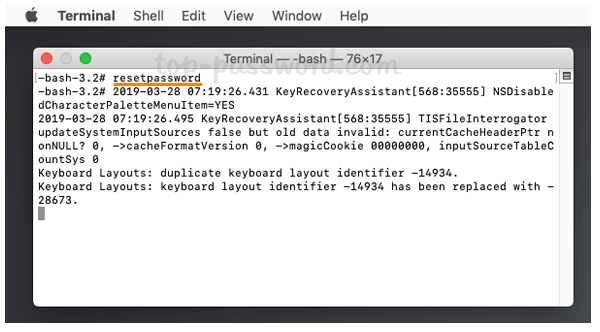

Enter the following command into the Terminal: cd /Volumes/Macintosh HD/var/db/. From the Edit menu, select Disable Root User. Pull down the ‘Utilities’ menu and choose Terminal.Click the lock and authenticate with an administrator account.Click Join, as shown in the figure below.Click the lock icon and authenticate with an administrator account.From the Apple menu, select System Preferences.
#Reset mac os x admin how to
Here’s how to disable the root user account on a Mac: Once you’ve used the root user account to flex your superuser muscles, you should consider disabling it for security purposes. Remember, you should only log in as the root user when absolutely necessary.
#Reset mac os x admin password
Enter the root user account password and you’ll be acting as the root user for the duration of your Terminal session, or until you type exit. If you’re an expert at the command line and would rather not log in to your computer as the root user, you can enter the su command in the Terminal application. Follow the instructions in our How to Password Protect Your Mac tutorial. Tip: To log in as root from the macOS login screen, you must have automatic login and FileVault disabled. You’ll be logged in as root until you log out, restart, or shut down your computer. When the list of users appears, click Other, type root in the Name field, and enter your root password in the password field. Now you can log in as the root user at the macOS login screen. 8 Comments Did you forget or lose the password for your Mac’s user account Thankfully, macOS Big Sur, Catalina, and Mojave make it easy to reset this password, and you can do it in a matter of seconds regardless of what Mac you own, with the help of your Apple ID.

The Directory Utility window appears.įrom the Edit menu, select Enable Root User.Įnter the password for the root user in the Password and Verify fields.Ĭlick OK to enable the root user and save the password. Ready to turn on your Mac’s superuser account? Here’s how to enable the root user account on a Mac and set the password:įrom the Apple menu, select System Preferences.Ĭlick the lock icon and authenticate with an administrator account.Ĭlick Join, as shown in the figure below.Ĭlick the Open Directory Utility button. System administrators consider using sudo a best practice - you should always try using sudo before you log in as root! Enabling the Root User Account OS X- Changing or resetting an account password (Snow Leopard and earlier).Most commands can be executed with sudo, but you’ll need to authenticate with your administrator password to execute the command as root. Mac OS X 10.6- If you forget your administrator password, OS X Lion- Apple ID can be used to reset your user account password.įor Snow Leopard and earlier with installer DVD to use local fonts Disable the left/right swipe gesture (Mac only). OS X Mountain Lion- Reset a login password , Who can use this feature Supported on any team or plan You can use Figma on. Instructions in the dialog window that will appear. Finally create new recovery key(s): sudo fdesetup changerecovery -personal and make a (physical) note of itthem and store it at a safe place. Reboot and login as new newadmin Downgrade the exstandarduser admin to a standard user. When the menubar appears select Terminal from the Utilities menu.Įnter resetpassword at the prompt and press RETURN. Check that the new admin is added to the FV users: sudo fdesetup list. Mac OS X 10.6- If you forget your administrator password. For Snow Leopard and earlier with installer DVD. OS X Lion- Apple ID can be used to reset your user account password.

Select the Recovery HD and click on the downward pointing arrow button. Or see Reset a Mac OS X 10.7 Lion Password, OS X Mountain Lion- Reset a login password, and. Alternatively, restart the computer and after the chime press and hold down the OPTION key until the boot manager screen appears. Restart the computer and after the chime press and hold down the COMMAND and R keys until the menu screen appears.


 0 kommentar(er)
0 kommentar(er)
